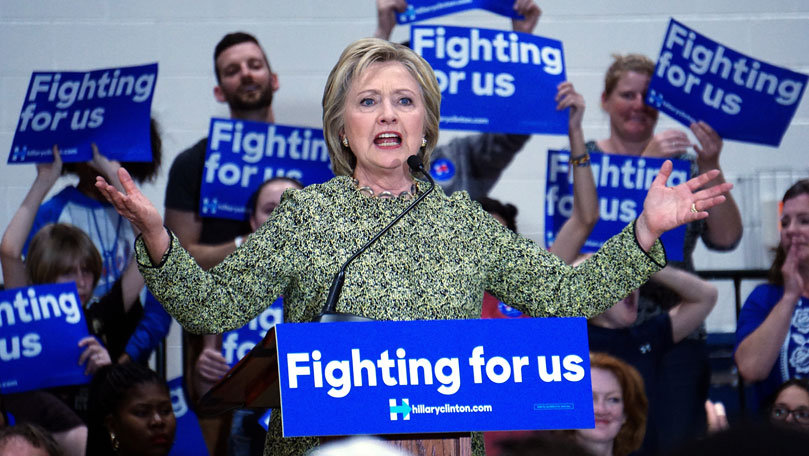
National Board Update 3/2/16
Joelle Fishman, Chair Political Action Commission CPUSA
Super Tuesday further underscores that this election is critical for the future of democracy in our country, and for our ability to move forward and not go back.
Republican side
Trump dominated. The Republican party is split. They are very dangerous. Workers rights, immigrant rights, women’s rights and the Supreme Court arevall on the line. Trump says he will bring back jobs but what kind of jobs, what kind of militaristic world? He was slow to disavow from the KKK, and has ejected African Americans from his rallies. The other Republicans are just as dangerous. They would all carry out austerity. This has to be exposed.
The contrast between the Republican and Democrat candidates is very clear. Trump and the Republicans are presenting a demagogic agenda preying on economic insecurity with hatred, bigotry, militarism and fear. The Democrats are presenting a progressive direction to expand education, health care, jobs and equality for everyone. Enormous credit has to be given to the Sanders campaign for changing the debate and going onto the offensive for working people’s needs, taking on the billionaire class and at the same time making defeat of the Republicans top priority. Hillary Clinton is picking up on much of that in her speeches. Especially, the Sanders campaign emphasis on the need for a political revolution and engaging millions and millions of people to end big money control of our political system is a major contribution that has the potential to go far beyond this election.
Democratic side
Hillary Clinton prevailed in the Red states in the South: Tennessee, Arkansas, Georgia, Alabama and Texas, and the swing state of Virginia, and she narrowly carried the blue state of Massachusetts.
Bernie Sanders carried traditionally blue states of Vermont, Minnesota, Colorado, and the swing state of Oklahoma.
Hillary Clinton carried the African American vote in the South overwhelmingly. However, the voter turnout was significantly down from 2008.
Bernie Sanders will bring the campaign to all 50 states. This provides the opportunity to expand the political revolution and to reach out strategically to African American, Latino, Native American and Asian Pacific voters. That unity is essential to succeed in and beyond the election.
Here are small reports from on the ground in four Super Tuesday states:
1. Minnesota
Sanders won over 60% of the vote, and won in all 8 Congressional Districts. Heavy crowds were reported at the caucuses of both parties.
Bernie Sanders spent time and money in Minnesota. People want fundamental change. He connected well with people in Minnesota. He did really well among young people, but also got support among some older people.
He did well with Native American, Hispanic, Somali and other African immigrants, and he did much better with African American voters than other states. He had the support of the $15 Now movement, and from leaders of Black Lives Matter. Congressman Keith Ellison supported Bernie Sanders, and was the only elected official to do so.
Hillary Clinton had the backing of all political leaders except Keith Ellison. She campaigned hard in Minnesota including on Super Tuesday.
A note of concern is the support for Trump by a number of low wage workers and some union members. This is discussed in the AFL-CIO’s Working America survey. There is an important role that Bernie Sanders plays to bring those voters back.
2. Virginia
Clinton won 64 percent of the vote. Sanders won 35 percent. On the Republican side Trump won.
This was a very different picture. In the areas of our state where reports came from, there was not much push for Democratic voters. Many people did not bother to vote including in African American communities.
In one community that is largely African American and immigrant the Sanders campaign made no effort to reach minority voters. Overall, the outreach was amateurish.
Virginia is an important swing state. Voters there went for Obama, elected a Democratic Governor, but is is not a safe state for Democrats. A massive turnout of African American, Latino, and youth voters is needed to defeat Republicans in November.
3. Texas
Clinton won 65 percent of the vote. Sanders won 33 percent. Cruz won 43 percent. Trump came in second with 26 percent.
Democratic voter turnout was down. It was alarming that Republican turnout was twice as high as Democratic turnout.
Bernie Sanders carried 13 counties and tied in two. His biggest vote came from Austin.
The African American vote went largely to Hillary. Among youth, the majority voted for Bernie.
The majority of the Hispanic vote was for Hillary, but more Hispanic voters chose Bernie than in some states.
The 200 people at the Watch Party were happy with four states going for a socialist. The volunteers made 3 million calls for Bernie Sanders in Texas, next calling into Louisiana. This group is the basis to become a progressive alliance after the elections.
4. Colorado
Bernie Sanders won 59 percent. Hillary Clinton won 40 percent.
There was a huge amazing turnout at the caucuses. Some had to move outside into parking lots.
Denver was not the highest vote for Sanders, outlying areas were even stronger.
There was a big turnout of young people for Bernie Sanders. Sanders spent money on TV and radio and held several very large rallies which did result in turnout.
This can change, from precinct caucuses to county to state. The big task is turnout in November.
Some preliminary conclusions and questions:
Turnout:
A massive Democrat turnout will be necessary to defeat the extremist Republicans in the general election. That will take the combined supporters of Hillary Clinton and Bernie Sanders and much, much more.
The Democratic turnout in 11 Super Tuesday states was 5.8 million compared to 8.5 million in 2008 (reflecting the high support for Barack Obama). In contrast, Republican turnout was up by 107 percent from 2008 and up 282 percent from 2012. Trump is attracting turnout based on demagogy. This has to be studied further, including voter suppression methods.
Role of the labor movement:
In the interests of unity in the general election, the AFL-CIO chose not to endorse a presidential candidate in the primary. 24 Internationals have endorsed Hillary Clinton. Several have endorsed Bernie Sanders. The survey by Working America in mostly white working-class areas between Cleveland and Pittsburgh found that Trump appealed to people who are worse off economically and don’t see power of collective action. Conversation on the issues and solutions with these voters was often able to turn this around. Bernie Sanders campaign can be helpful in this regard.
Sanders campaign:
The Sanders campaign is moving the entire electorate in a progressive and left direction. It is raising the question that system as a whole is rigged against working people. It is opening a discussion of socialism. In addition to the class struggle program, it is raising the transformation of politics in our country. It is succeeding in building a grassroots movement that will have profound long lasting impact. His concept of a political revolution, inspiring millions of people engaged for the first time, and his lesson that no president can achieve a people’s program alone because winning any real reform will take the organized demand of a majority of people. He has popularized the idea of socialism and the role of government to meet the needs of the majority of people, not the top .1 percent. The response to the Sanders campaign represents an upsurge for democracy in our country. The biggest challenge will be to keep that movement going and growing until November, with a groundswell that can strengthen the peoples’ movements beyond the elections. Local organizing along these lines has made a difference in the outcome and in the composition of the vote for Bernie Sanders.
Long-term Organizing:
It will take the broadest unity possible to defeat the extremist Republicans in November. Unity can be built around issue campaigns, especially the Fight for $15, Black Lives Matter, the Dreamers rallies, student debt and climate change protests. Placing the fight against racism and for equality up front and enhancing class consciousness will push in a more progressive direction.
There are many inspiring experiences from around the country. In Iowa a targeted and organized effort to turn out the Latino vote brought out more youth and made the difference in the vote for Sanders. In many places new activists seek us out and we are growing. Messaging and organizing techniques geared to bring out the vote among young people across racial lines are being learned.
The Communist Party does not endorse candidates other than our own. We are committed to a political agenda that meets the needs of people and expanding the political revolution by bringing new voters into the process and organizing a massive turnout for president and for Congress and state houses. We are committed to work in a way that builds grassroots structures for the long term that can bring forward new left and progressive candidates on the state and local level. We are committed to use our media to provide clarity, deepen class consciousness and build unity, for example John Bachtell’s recent article on Bernie Sanders and Larry Rubin’s article on Super Tuesday.
Jarvis Tyner spoke at five African American History Month events in Connecticut over the weekend. His message was well received – he said “I Feel the Bern. Whoever the nominee is, we must all be prepared to support in order to defeat Trump and the Republicans in November.”
Rick Nagin’s “Handy Guide to Capitalism and Socialism” is well received and should be circulated widely.
Photo: Creative Commons 3.0


 Join Now
Join Now